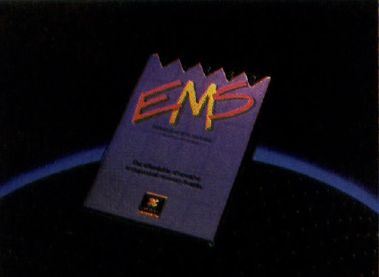TURBO EMS
Computer users are constantly trying to stuff more features into their new programs or add just a few more fields to their databases. Luckily, there are products like Turbo EMS to help you stuff in a little more.
If you found yourself in the past hitting your head on the 640K ceiling in your PC, you've probably already purchased a Lotus/Intel/Microsoft (LIM) Expanded Memory Specification (EMS) memory board. EMS allows programs to store data in memory outside the normal DOS 640K area, using a technique called bank-switching to shuttle needed information in and out. If you run into limitations only occasionally, you may have decided the cost is too great compared with the infrequent benefit. Either way, Turbo EMS can help you go beyond your current limits.
Turbo EMS offers a middle-of-the-road solution, letting you use your PC's existing memory (including EMS memory boards and ramdisks) and then use your hard disk for a total of up to 32 megabytes of simulated EMS memory. If you're desperate, you can even use a floppy disk for extra EMS memory, because the program lets any recognized DOS drive simulate EMS.
Turbo EMS simulates LIM EMS version 4.0, even when using LIM 3.2 memory boards. The program optimizes performance by using actual random access memory first. Next, Turbo EMS uses disk storage, including drives over 32 megabytes, and even networked drives. Turbo EMS also supports the LIM Extended Memory Specification 2.0 for extended memory, a new standard which may become important in the future.
This all comes at a price. Your PCs processing speed and hard disk access times will determine how fast programs will operate under Turbo EMS. Even fast hard disks are dismally slow compared with RAM.

However, Turbo EMS will make it possible to do things you could not do before. It provides extra room for large spreadsheet, database, CAD, and other files. It will also free up some of the most precious memory, conventional memory below the 640K limit, for TSRs and application programs.
For example, one sample spreadsheet file of 265,370 bytes created in Lotus 1-2-3 left less than 1 percent of conventional memory free (58 of 309,536 bytes) without Turbo EMS. Activating Turbo EMS stole some available conventional memory from 1-2-3, but it actually increased the amount of memory available for other applications. The same spreadsheet loaded into 1-2-3 with Turbo EMS providing one megabyte of EMS on a hard disk left about 84 percent of the remaining available conventional memory (202,672 of 239,104 bytes, an increase of 239,046 bytes) free for other tasks.
Processing slowed since Turbo EMS had to bank-switch the spreadsheet file in and out of RAM when I moved around the screen, saved and retrieved files, and recalculated my spreadsheet. On a 10-MHz AT compatible with a 28-ms-access-time Miniscribe 6053 hard drive, the conventional memory spreadsheet took about 5 seconds to recalculate. Under Turbo EMS, the spreadsheet took about 11 seconds to recalculate.
File retrieves took 17 and 65 seconds, respectively; saves took 15 and 65 seconds. The simple tests dramatically point out that using a hard disk as EMS memory is considerably slower than using internal RAM or EMS memory boards.
On the other hand, Turbo EMS makes it possible to increase the size of the sample file far beyond what was possible before. Further, Turbo EMS makes it possible to execute the /SYSTEM command to use DOS. Without Turbo EMS, 1-2-3 had too little memory to invoke DOS while the sample spreadsheet was in memory.
Turbo EMS's menu-based installation is simple, with help screens providing basic information. The manual is easy to read, understandable, and informative; it also provides essential information not presented in the help screens.
Turbo EMS is a good product in the right situation. If you have unlimited funds and frequently need more memory, go out and buy the biggest and fastest EMS board you can find. However, Turbo EMS is an excellent option if you have limited funds and occasionally need more memory—as long as you don't mind waiting a little longer for results.
J. BLAKE LAMBERT
|
IBM PC and compatibles—$99.95 LANTANA TECHNOLOGY |